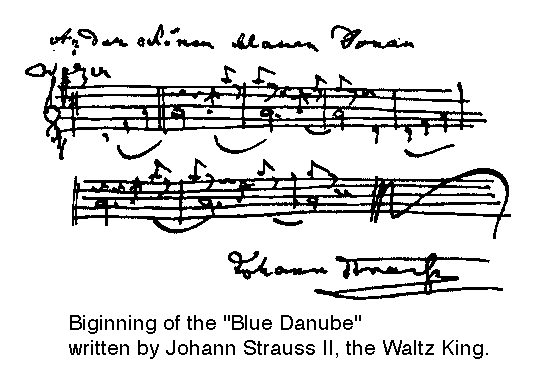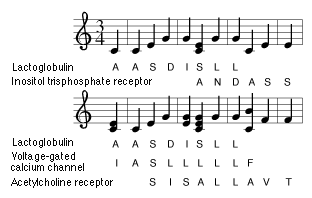The year of 1866. In Japan, the end of the Edo era was approaching and
the Meiji Restoration was just near. In central Europe, on the other hand,
 Prusso-Austrian War broke out and the Austrian Army was defeated.
Injured soldiers were seen everywhere in Vienna, the capital of Austria
Empire. The Austrian people was completely dispirited. Prusso-Austrian War broke out and the Austrian Army was defeated.
Injured soldiers were seen everywhere in Vienna, the capital of Austria
Empire. The Austrian people was completely dispirited.
About that time, Johann Strauss II was asked to compose a waltz for chorus.
Enthusiastic patriot, he must have thought to compose a melody which consoles
and cheers the crushed Austrian people. Even if the nation is defeated in
a war, the nature remains just as before. The "Blue Danube" was
born the next year in such a situation.
The body begins to move spontaneously. This is the ultimate waltz!
Analyzing the melody of the famous waltz, Dr. Sternheimer says: "To
dance waltz, smooth motion is important: relaxation and tension of muscles
must be well coordinated.
So as to function muscles, calcium is inevitable. To our surprise, in the
theme of the first waltz of the "Blue Danube", one finds melody
pieces of four proteins which have relation with calcium. The four proteins
are lactoglobulin, inositol trisphosphate receptor, voltage-gated calcium
channel, and acetylcholine receptor. As can be seen from the attached partial
score, the melody pieces are related in such a way that a melody piece is
superposed at the end on the beginning of another and so on, then producing
harmony.
The meaning of the composite melody can be known by examining the  function of each protein: the melody works upon our body to relax first
, then to prepare for dance, and finally to begin dance actually. This is
a quite reasonable composition to tempt us naturally to dance. We may say,
therefore, that the composite melody or the first waltz of the "Blue
Danube" is really a representative melody for 'invitation to dance'". function of each protein: the melody works upon our body to relax first
, then to prepare for dance, and finally to begin dance actually. This is
a quite reasonable composition to tempt us naturally to dance. We may say,
therefore, that the composite melody or the first waltz of the "Blue
Danube" is really a representative melody for 'invitation to dance'".
It is difficult to believe that such harmonious superpositions of melody
pieces are realized by chance. Surely no! "Such superpositions are
a proof that 'scaling waves' are concerned in the coordination of the proteins.",
says Dr. Sternheimer. Scaling waves, which are microscopic waves he has
discovered, are produced notably during protein synthesis and have influence
on the synthesis through a resonance phenomenon. The audible transposition
of the waves also has similar effects. Thus the scaling waves would account
for the usefulness of music to coordinate different proteins and also to
help to coordinate smooth movement of different parts of ourselves.
The reason why the "Blue Danube" becomes an excellent piece
of music in the history
Concerning the "Blue Danube", Brahms, a friend of Strauss II,
wrote on a fan of a lady the opening several measures of the waltz, and
underneath: Alas, not by Brahms. Dr. Sternheimer comments about this as
follows: "All of us have potentially in ourselves the beginning of
the melody.  Nevertheless, what a surprise that essentials for coordination
of movements of muscles are included in such short passages! This is the
point of the waltz and, therefore, accounts for the fact that it became
'the most famous waltz in the history', as has been said. Brahms may have
felt and understood the music to concern him deeply inside, reason why he
wrote such a phrase". Nevertheless, what a surprise that essentials for coordination
of movements of muscles are included in such short passages! This is the
point of the waltz and, therefore, accounts for the fact that it became
'the most famous waltz in the history', as has been said. Brahms may have
felt and understood the music to concern him deeply inside, reason why he
wrote such a phrase".
People all over the world danced with elegant waltzes of Strauss II, the
Waltz King. However, the greatest irony for him will be that he himself
could not dance. About this, he confessed to a friend: "I have never
been a dancer. How tempting the 'Invitation to dance' may be, I should absolutely
say 'No' ".
Although he could not dance, he draws us smoothly into the movement of waltz
with the "Blue Danube". In addition, although he was not a scientist,
he unconsciously incorporated into the melody a hint to solve a hot theme
which is the relation between inositol trisphosphate receptor and voltage-gated
calcium channel and which puzzles biochemists of more than 100 years later! |
 Prusso-Austrian War broke out and the Austrian Army was defeated.
Injured soldiers were seen everywhere in Vienna, the capital of Austria
Empire. The Austrian people was completely dispirited.
Prusso-Austrian War broke out and the Austrian Army was defeated.
Injured soldiers were seen everywhere in Vienna, the capital of Austria
Empire. The Austrian people was completely dispirited. function of each protein: the melody works upon our body to relax first
, then to prepare for dance, and finally to begin dance actually. This is
a quite reasonable composition to tempt us naturally to dance. We may say,
therefore, that the composite melody or the first waltz of the "Blue
Danube" is really a representative melody for 'invitation to dance'".
function of each protein: the melody works upon our body to relax first
, then to prepare for dance, and finally to begin dance actually. This is
a quite reasonable composition to tempt us naturally to dance. We may say,
therefore, that the composite melody or the first waltz of the "Blue
Danube" is really a representative melody for 'invitation to dance'". Nevertheless, what a surprise that essentials for coordination
of movements of muscles are included in such short passages! This is the
point of the waltz and, therefore, accounts for the fact that it became
'the most famous waltz in the history', as has been said. Brahms may have
felt and understood the music to concern him deeply inside, reason why he
wrote such a phrase".
Nevertheless, what a surprise that essentials for coordination
of movements of muscles are included in such short passages! This is the
point of the waltz and, therefore, accounts for the fact that it became
'the most famous waltz in the history', as has been said. Brahms may have
felt and understood the music to concern him deeply inside, reason why he
wrote such a phrase".